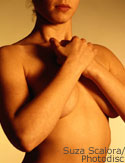Beauty and the Bust
Five Ways to Keep the Girls Happy and Healthy

1. Use the miracle cream! Firming and toning creams won't make any difference, but one rub-on item works wonders: SPF 30. Here's why:
3. Start exercising. Many a AA-cup adolescent has already discovered that no exercise can enlarge your bra size. Here's what you can do:
- Overexposure to sun breaks down the elastin and collagen in your skin, causing it to sag.
- Brown "age" spots that appear in cleavage have little to do with getting older and everything to do with sun exposure.
- After applying sunscreen, allow 30 minutes for your skin to absorb it before going outdoors.
- Avoid dabbing alcohol-based perfume between your breasts. It may increase photosensitivity.
- If you already have sun damage, dermatologists say a prescription-strength vitamin A cream may help fade brown spots. However, it may take laser resurfacing or a chemical peel to eliminate spots completely.
3. Start exercising. Many a AA-cup adolescent has already discovered that no exercise can enlarge your bra size. Here's what you can do:
- Perk yourself up with strength-training moves that bolster the breasts' underlying muscles, the pectorals.
- Push-ups (the exercise, not the bras) are effective; or ask a trainer how to use dumbbells to tone your chest.
- Keeping yourself from gaining and losing a lot of weight is the best way to avoid stretch marks. Too late? According to dermatologists, if the lines are red, they're more responsive to laser. If they're white, no treatment will eliminate them completely.
- Because there's not a lot of fat over the sternum, the skin between the breasts is more sensitive than other areas.
- Detergents, fabric softeners, jewelry and even dye in clothing can be the culprits.
- If a product switch doesn't clear things up, prescription cortisone cream may help.
- Arrange for your first screening mammogram at age 40, then schedule one every year after that.
- Women ages 20 to 39 should have their breasts examined by a doctor at least every three years, according to the American Cancer Society.
- Go immediately if you feel a lump or notice a change in the nipple.
- No matter what age you are, regular self-exams are one of the best ways to detect cancer early.



